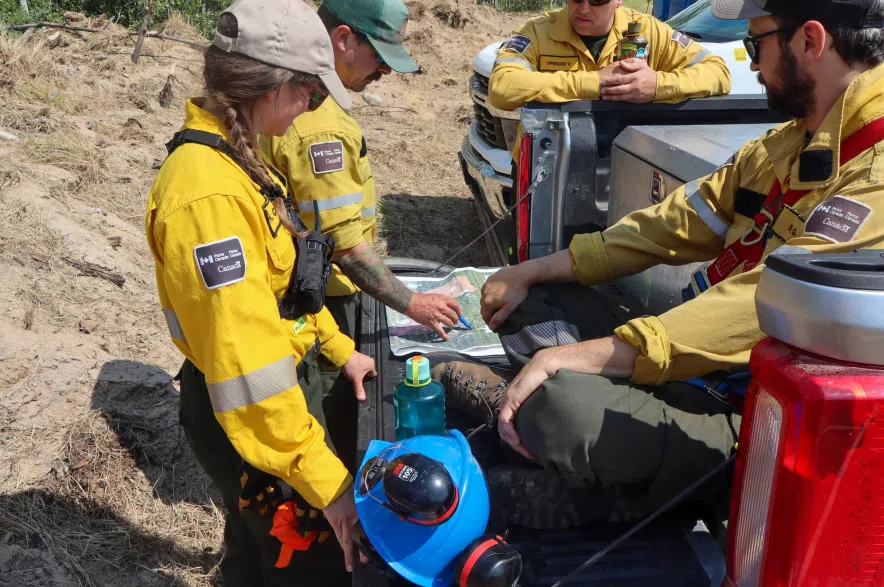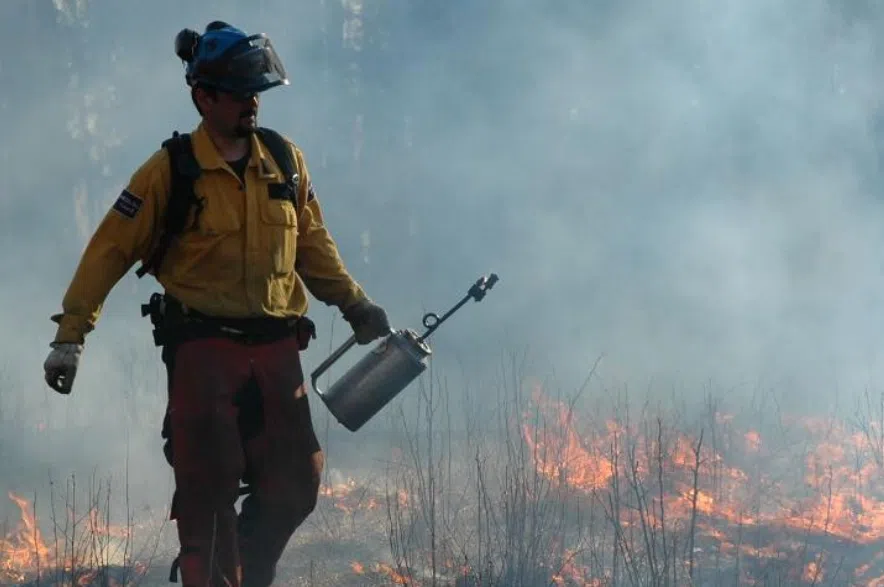by Teena Monteleone
As Saskatchewan experiences one of its worst wildfire seasons on record, smoke continues to prompt air quality alerts for the public.
There is no doubt firefighters who spend weeks on the front lines face the worst of it; however, less than five per cent of personnel working the wildfires in Saskatchewan are wearing masks, and despite the health risks, that’s not likely to change any time soon.
“Saskatchewan Public Safety Agency (SPSA) personnel have access to N95 masks if they wish to wear them on the fire line, but most choose to wear bandanas,” the SPSA wrote in an email to paNOW.
Structural firefighters within urban centres are required to wear self contained breathing apparatus (SCBA) to protect them from smoke inhalation and exposure to harmful airborne contaminants, but in Saskatchewan using facial protection is voluntary for wildland firefighters, and there is no provincial protocol to use them.
Studies have shown that wildfires can release methane, arsenic, nitrogen oxides, and carbon monoxide, among other pollutants.
The fine particulate matter is the greatest concern because it can travel deep into the lungs. N95 masks can help reduce exposure to fine particles, but don’t filter out harmful gases. Bandanas offer little to no protection.

Firefighters working to combat the Buhl Fire in Prince Albert National Park plan their next move earlier in August. (Parks Canada/Facebook)
Masks often considered ‘impractical’
The SPSA said it has done testing on a variety of mask options, but “none have been identified as designs they can or would use long term” while fighting forest fires.
Occupational health departments in wildfire-prone California have also conducted trials of masks or air-purifying respirators in recent years, but they too found them to be “impractical” for crew members who are already carrying heavy equipment loads and conducting rigorous work.
The British Columbia Wildfire Service introduced three respirator protection models for the 2024 wildfire season, but ultimately concluded they have limitations and are not a silver bullet for reducing exposure.
Brady Highway has been a firefighter for 31 years. He’s had his lungs collapse several times. It happened earlier this summer while working on the front lines in Pelican Narrows.
Despite that, he said he can’t imagine trying to perform his job in the future while wearing a mask all the time.
“Most of the firefighters I’ve ever worked with find that they are too laborious to breathe in. N95 masks end up becoming clogged up and they don’t allow for any kind of free breathing.
“This job that we undertake has a lot to do with endurance and having to be able to keep your heart rate under control by doing heavy lifting, and lots of endurance and stamina is needed, so it becomes pretty laborious to have to breathe through smoke and also have a clogged mask that becomes sweaty.”
Highway noted current breathing apparatus on the market require tanks that only last for 20 minutes, filters that need to be replaced continuously, and motors that need to be recharged.
“It’s unrealistic to carry SCBAs into the forest,” he said.
Need for better protection growing
However, with wildfire seasons starting earlier and becoming more intense, the need for better protection is growing.
Studies have shown people routinely exposed to wildfire smoke are at an increased risk of major health problems like cardiovascular disease and cancer. Just this month, Saskatchewan expanded cancer coverage of wildland firefighters.
The SPSA said it’s planning and working with the WCB to further distribute information to staff of the risks of smoke exposure.
“I think [the province] will also start to look at the technology a little more closely now that workers compensation has started to acknowledge that our lung damage and some of the sicknesses that we do have are contributable to wildland firefighting,” Highway said.
The SPSA said it stays up to date with research regarding respiratory protection and fire bosses do what they can to reduce exposure.
“Personnel are trained on weather and fire behaviour. This training enables personnel to be aware of their surroundings and allows them to better assess and predict what the fire could do.
“Staff are encouraged to leave highly smoky areas. It’s also recommended that they rest and stay hydrated, which has been proven to reduce the short-term effects of smoke inhalation.”
Highway agrees the best approach to avoid smoke is through tactics.
“Approach the fire from the rear and then use the wind to make sure that you’re always in some pocket of fresh air,” Highway said.
“So, if you’re working from behind the fire, you’re not going to get that direct shot of smoke.”
With such a small amount of SPSA personnel wearing respiratory protection in Saskatchewan, at least until a perfect protective mask is made for wildland firefighters and ultimately accepted by them, the reality is the people most exposed to the smoke may have the least protection.
Read more:











